Aircraft Systems and Navigational Aids
1/98
Earn XP
Description and Tags
An in depth Piper Archer II flashcard is in a different folder
Name | Mastery | Learn | Test | Matching | Spaced |
|---|
No study sessions yet.
99 Terms
What type of engine does the Archer II have? What does each letter mean?
Lycoming O-360-A4M or CL4HAND
C Carbureted
L Lycoming
4 4-Stroke
H Horizontally Opposed
A Air Cooled
N Naturally Aspirated
D Direct Drive
*360 is the engines total piston displacement in cubic inches
What is the skin of the Piper Archer made of?
Aluminum Alloy
What kind of structure does the Piper Archer have?
Semi-Monocoque:
What type of ailerons do we have? Why?
Differential Ailerons: They deflect up further than they deflect down which helps with Adverse Yaw
What is an anti-servo tab?
A small surface attached to the Stabilator which deflect further to prevent the pilot from overcontrolling the aircraft. It also serves as a trim tab.
What types of flaps do we have?
Slotted flaps, which help re-energize the air below the wing with the air on top. Helps reduce stall speed.
What is the manufacturer and diameter of our propeller?
Sensenich and 76 inches in diameter.
What oil do we use during the first 50 hours of engine use? What is used after?
Mineral Oil, then Ashless Dispersant
What type of oil sump does our aircraft have?
Wet-Type oil sump, meaning it stores the oil in a case below the engine. A dry-type stores it in a different container.
What type of oil do we use?
S.A.E. 40
What is our maximum Ramp, Takeoff, and Landing Weight?
Ramp: 2558
Takeoff: 2550
Landing: 2550
What are the two principles of gyroscopes?
Rigidity in Space: Maintain orientation in space and resists changes.
Precession: A force applied to the gyroscopic will be felt 90 degrees in the rotation of the gyroscope
Which instruments usually use a gyroscope?
Attitude Indicator and the Heading Indicator
What is the difference between a Turn Coordinator and a Turn-and-Slip Indicator
Turn Coordinator shows rate-of-turn and rate of roll, while the Turn-and-Slip Indicator shows only the rate of roll.
What are our Pitot-Static instruments?
Altimeter, Airspeed Indicator, and Vertical Speed Indicator
How does the Altimeter work?
The casing of the altimeter uses outside air pressure, while the aneroid wafer inside the casing expands and contracts as the static port fills outside air into the casing.
How does the aneroid wafer expanding and contracting translate to an altitude?
When the aneroid wafer contracts that means the aircraft is descending or at a lower altitude, while expansion means the aircraft is climbing/high altitude.
What is a “Sensitive Altimeter”? What is the window that displays the pressure setting called?
An altimeter with an altimeter setting knob. Kollsman Window.
When flying for an area of high to low pressure what should you keep in mind?
Flying high to low without adjusting your altimeter setting will result in your altimeter indicating higher, causing a pilot to fly lower than desired.
Name and define each type of altitude:
Indicated: Uncorrected altitude indicated when altimeter set to local pressure setting
Pressure: Altitude above standard pressure
Density: Pressure altitude corrected for non-temperature
Absolute: Height above the ground
True: Altitude above Mean Sea Level
How does the Vertical Speed Indicator work?
A diaphragm inside the instrument receives static air, the casing also receives air but has a calibrated leak (~6-9 seconds) which keeps old air inside for a short while this allows the diaphragm to expand and contract as you climb/descend
How does the Airspeed Indicator work?
The ASI measures the difference between incoming ram air from the pitot tube, and ambient pressure from the static port, the result is an airspeed indication or dynamic pressure.
Inside the instrument a diaphragm receives ram pressure, the outside receiving static pressure. The compression and expansion of this diaphragm translates to airspeed.
Name and define each type of speed:
Indicated: What the instrument displays
Calibrated: IAS corrected for instrument & position errors
Equivalent: CAS corrected for compressibility errors
When going extremely fast
True (TAS): Actual speed of the aircraft through the air, CAS corrected for non-standard temp and pressure
Ground Speed: Speed over the ground, also TAS corrected for wind
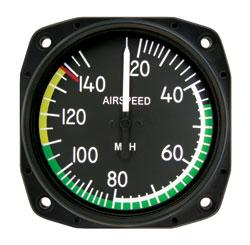
What does each airspeed indication mean?
White Arc: Flaps extended speed, between Vso - Vfe
Green Arc: Normal operating range, starts at Vs1 and ends at Vno
Yellow Arc: Caution range, fly only in smooth air
Red line: Vne
What is all of our Vspeeds?
Vso: 45
Vs1: 50
Vr: 60
Vx: 64
Vy: 76
Vref: 76
Vfe: 102
Va: 89-113
Vno: 125
Vne: 154
What happens if the Pitot Tube is blocked (Static is clear)?
ASI: Reads Zero
Altimeter: Nothing
VSI: Nothing
What happens if the Pitot Tube and Drain Hole are blocked?
ASI: Increased with altitude
Altimeter: Nothing
VSI: Nothing
What happens if the Static Port is blocked (Pitot is clear)?
ASI: Decreases with altitude
Altimeter: Frozen in place
VSI: Reads Zero
What are some ways you can remedy an inaccurate Altimeter or VSI?
Using the Alternate Static Source, breaking the VSI glass if that does not work
Why do we have to constantly align the Heading Indicator with the Magnetic Compass?
Because of Precession
What are the magnetic compass errors and limitations?
D Deviation
V Variation
M Magnetic Dip
O Oscillation
N North/South turn errors (UNOS)
A Acceleration errors (ANDS)
What is an Attitude Heading Reference Systems (AHRS)?
Provides more accurate and reliable attitude and heading data
What is an Air Data Computer (ADC)?
Replaces the mechanical pitot-static instruments, ADC receives input from pitot, static, and outside temp ports, and computes: airspeed, true airspeed, vertical speed, and altitude.
What is a flight director?
Computes and displays purple bars over the attitude to help in flight
What is a Flight Management Systems?
Receives input from various systems and sensors and provides guidance to the autopilot and flight director.
What is an Electronic Flight Instrument System?
A Glass Cockpit
What is a Primary Flight Display (PFD)?
Displays flight data such as attitude, altitude, airspeed, VSI, and heading as well as rate tapes.
What is a Multi-Function Display (MFD)?
Display secondary information, like maps, system status, weather, and traffic. Can also be used as a backup for other displays.
When is an approved flotation device for each occupant, and at least pyrotechnic signaling device?
When operating for hire over water and are beyond power-off gliding distance from shore.
What frequencies are reserved for VORs?
108.0 to 117.95 MHz excluding 108.10-111.95 with odd tenths for LOC frequencies
What is the VOR MON (Minimum Operation Network) do?
A program that ensures that as old VORs are phased out, a MON airport (with legacy ILS or VOR approaches) is available within 100 NM is available regardless of aircraft position in the CONUS.
What are the different VOR Receiver Checks?
V VOT: ± 4
O Over a prominent landmark, minimum 20 NM at a reasonably low altitude: ± 6
D Dual: ± 4
G Ground: ± 4
A Airborne: ± 6
What is the required information needed to be logged after a VOR check?
DEPS
D Date
E Error (bearing error)
P Place
S Signature
What are the limitations that a VOR has?
Cone of confusion, reverse sensing, and it requires line of sight between the aircraft and station.
What is the service volume for a Terminal VOR?
Radius: 25 NM
Altitude: 1,000-12,000’

What is the service volume for a Low VOR?
Layer 2: 70 NM from 5,000’ to 18,000’
Layer 1: 40 NM from 1,000’ to 5,000’
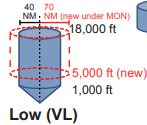
What is the service volume for a High VOR?
Layer 5: 100 NM from 45,000’ to 60,000’
Layer 4: 130 NM from 18,000’ to 45,000’
Layer 3: 100 NM from 14,500’ to 18,000’
Layer 2: 70 NM from 5,000’ to 14,500’
Layer 1: 40 NM from 1,000’ to 5,000’
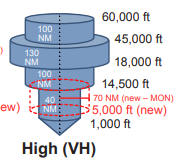
What frequencies does DME occupy?
962-1213 MHz
How does DME work?
The aircraft transmits an “interrogation” signal which is received and replied to by the ground DME facility. The airborne unit then calculates the slant range distance to the station based on reply time.
What is slant range error? When is it negligible?
When over the DME facility instead of displaying 0 it displays 1. That is because for every 1 NM the aircraft should be 1,000’ of altitude. So it would be negligible at distances like 5 NM at 5,000’.
What is the service volume for DME Low (DL)?
Layer 2: 130 NM from 12,900’ to 18,000
Layer 1: From the surface to 12,900’ you need LOS
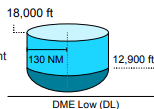
What is the service volume for DME High (DH)?
Layer 3: 100 NM from 45,000’ to 60,000’ ATH
Layer 2: 130 NM from 12,900’ to 45,000’
Layer 1: From the surface to 12,900’ you need LOS
*ATH = Above Transmitter Height
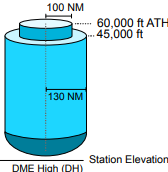
What is an ADF?
An Automatic Direction Finder which points towards the NDB
What are the NDB Service Volume Classes?
Compass Locator: 15 NM
Medium High (MH): 25 NM
High (H): 50 NM (Or less, see NOTAM or Chart Supplement)
High High (HH): 75 NM
What is a compass locator?
A low powered NDB installed at the OM or MM on some ILS approaches.
How does an ADF work?
You tune in an NDB station on the ADF, the instrument will then show the direction of that NDB. Some ADF’s show the bearing relative to North, some show relative to aircraft.
What is a Localizer? What is its range of frequencies?
A part of a landing system that gives later course guidance. 108.1-119.95 MHz with odd tenths only
Draw what a Localizer looks like:
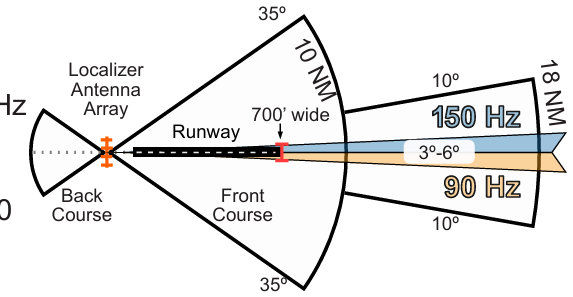
Draw what an ILS looks like:
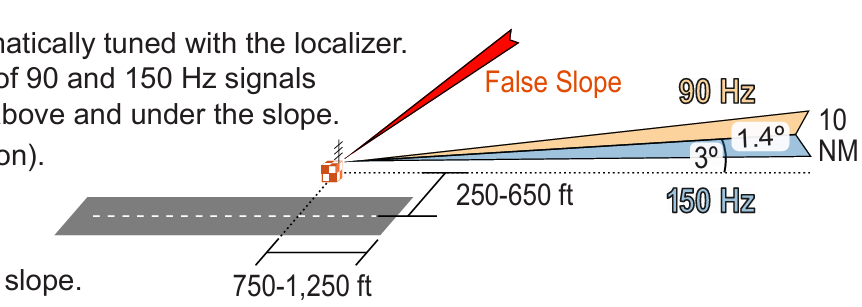
What is the width of the LOC?
Between 3 to 6 degrees, this is so the width at the threshold is 700’ wide
What is the coverage range of a LOC?
First 10 NM: 35 degrees to each side of the centerline
Last 18 NM: 10 degrees from each side of the LOC antenna up to 4,500’
How does the glide slop know how high or low the aircraft is?
Vertical position is interpreted by the intensity of the 90 and 150 Hz signal carried over the UHF frequency and directed above and under the slope
What is the width of the glide slope?
Width is 1.4 degrees, full deflection is 0.7 degrees.
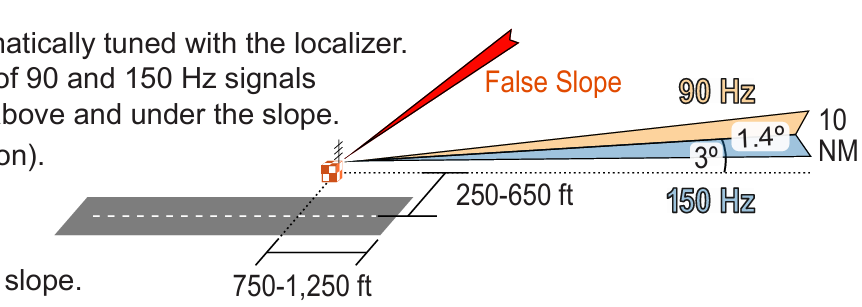
What is the range of the glideslope?
Up to 10 NM
What is a “False Glideslope”?
A secondary glide slope above the actual one. This false glide slope has a very steep descent rate inconsistent with an actual glide slope.
What does the Outer Marker Mean? How can we identify it from the others?
Usually 4-7 miles out and indicates when the GS should be captured.
Morse Code: “- - -”
What does the Middle Marker Mean? How can we identify it from the others?
Usually ~3,500’ from the runway (200’ above TDZE), and is at when the GS meets the DA.
Morse Code: “. - . -”
What does the Inner Marker Mean? How can we identify it from the others?
Between the Runway Threshold and Middle Marker, also indicates GS and DA intersection on CAT II ILS.
Morse Code: “. . .”
What does the Back Course Marker Mean? How can we identify it from the others?
Indicates FAF on selected back course approaches
Morse Code: “.. ..”
What is an Approach Light System?
Basic visible indications between instrument guided flight into a visual approach.
Precision: 2,400’-3,000’
Non-Precision: 1,400’-1,500’
How far from the landing area does ALS for a Non-Precision Approach Runway extend?
2,400’ to 3,000’
How far from the landing area does ALS for a Precision Approach Runway extend?
1,400’ to 1,500’
What is the lowest visibility for each category of ILS?

What is RNAV?
Area Navigation that allows flying any desired path, without needing to overfly ground-based facilities.
What are the types of RNAV?
Global Navigation Satellite System (GNSS)
VOR/DME RNAV
DME/DME RNAV
Inertial Reference Unit/System (IRU/IRS)
What is RNAV VNAV and BARO-VNAV?
1. Vertical Navigation Guidance
2. An RNAV system that uses barometric altitude to compute vertical guidance
What are the types of published RNAV routes?
Q-Routes: FL180-FL450
T-Routes: 1,200’ AGL-18,000’ MSL
*Both designated as RNAV 2 unless charted as RNAV 1
What type of RNAV routes do we fly?
T-Routes
What is Magnetic Reference Bearing (MRB)?
The published bearing between two waypoint on an RNAV route?
How many satellites make up the GPS constellation?
Minimum 24 orbiting at 10,900 NM, designed so 5 are at view at any time.
How many satellites are required for 2D and 3D position?
2D: 3 Satellites
3D: 4 Satellites (Latitude, Longitude, and Altitude)
What is Receiver Autonomous Integrity Monitoring (RAIM)?
A function of GPS receivers that monitors the integrity of the satellite signals
How does RAIM Fault Detection work?
Requires minimum of 5 satellites or 4 + baro-aided RAIM to detect a faulty signal
How does RAIM Fault Exclusion work?
To eliminate a corrupt satellite RAIM needs an additional satellite (6 or 5 + baro-aid), the new satellite replaces the corrupt one
What is great-circle navigation?
Computes the shortest path between two points
Can GPS substitute ADF or DME?
Yes, except for ADF on an NDB approach without GPS overlay (“or GPS” in the title)
How can a pilot make sure RAIM is available for the entire flight?
By using the FAA’s RAIM prediction tool, and checking GPS NOTAMS
What is GPS Augmentation System or Differential GPS (DGPS)?
Improve the accuracy of GPS by measuring errors received by reference stations at knows locations and transmitting these errors to GPS receivers.
What is Satellite Based Augmentation System (SBAS)?
SBAS improves accuracy, integrity and availability by having ground stations measure GPS errors that then produce correction signals received by satellites which then are sent to aircraft GPS WAAS receivers.
Facilitates APV approaches like LPV LNAV/VNAV and non precision LP approaches
What is Ground Based Augmentation System (formerly Local Area Augmentation System (LAAS))?
Errors broadcasted via VHF to GBAS-enabled GPS receivers, more accurate than WAAS but covers a smaller area.
Allows for Cat I and above approaches to GLS DA minima
What is Required Navigation Performance (RNP)?
A statement of navigation equipment and service performance, RNAV with navigation monitoring and alerting
All RNAV approaches are RNP approaches
What does it mean when an approach has RNAV (RNP)?
It means the approach is “Authorization Required” and need special permission from the FAA for the crew, aircraft, and operation.
Other countries may have “RNP” in the approach title without needing permission
What are the different types of RNP approach minimums?
GLS: DA using GBAS
LP: MDA
LPV: DA minima require RNP achieved by WAAS
LNAV/VNAV: DA achieved by VNAV approved WAAS, or BARO-VNAV systems
LNAV: MDA achieved by basic un-augmented IFR-approved GPS
What is PBN (Performance Based Navigation)?
The general basis for navigation equipment standards in terms of accuracy for specific situations (approach, enroute, missed approach).
What is the RNP accuracy for Enroute, Terminal & Departure, and Final Approach?
Enroute: 2 NM 95% of flight time
Terminal & Departure: 1 NM 95% of flight time
Final Approach: 0.3 NM 95% of flight time
What is Advanced RNP (A-RNP)?
A higher standard mandatory for RNP AR
What are the types of precision approaches?
ILS - Instrument Landing System
PAR - Precision Approach Radar
GLS - GBAS Landing System
What are the types of Non-Precision approaches?
VOR
NDB
RNAV/RNP to LNAV or LP minima
LOC - Localizer
LDA - Localizer-type Directional Aid
SDF - Simplified Directional Facility: Similar to a LOC with 6 or 12 degree width, may be aligned or not with the runway
ASR - Approach Surveillance Radar
What is an APV and what are the different types of Approaches with Vertical Guidance (APV)?
A precision-like approach, flown to a DA with lateral + vertical guidance but does not meet precision approach standards
RNAV/GNSS (LNAV/VNAV and LPV minima)
LDA with Glide Slope